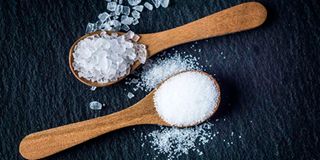Are the proclaimed benefits of Himalayan Pink Salt real?

Iodine is usually added to table salt during processing.
What you need to know:
- Although Himalayan salt does not have discernible health benefits over regular table salt, it is not useless.
- Regular table salt often has anti-caking additives which are not necessary for Himalayan pink salt. For this reason, the pink salt is arguably purer.
The salt section of your grocery store is not as plain as it was a few decades ago. There are various alternatives to traditional table salt, most of which are claimed to offer health benefits. The Himalayan pink salt is one of the most notable additions on the shelves.
For years now, the pink salt has been marketed as a better alternative to the regular table salt, with far-reaching health benefits. While some sellers and users swear by the Himalayan pink salt, skeptics believe the health benefits have been overhyped to increase sales. Who is on the right side?
The Himalayan Salt: What is it?
The Himalayan pink salt has an unmistakable and distinguishing pink hue. It is mined near the foot of the Himalayan mountains in the Punjab region of Pakistan, hence the name. While other salts are usually mined through the evaporation of lakes and seas, the Himalayan pink salt is mined as a rock. Many publications, therefore, erroneously claim that it is not sea salt. Experts, however, classify it as sea salt because the current rocks of salt were formed from the evaporation of a landlocked sea millions of years ago.
Nutritional composition
Other than the colour, the Himalayan pink salt differs from the regular table salt in composition too. While the normal table salt contains around 2300mg of sodium per tablespoon, the Himalayan pink salt averages 1600mg per tablespoon.
In turn, the Himalayan pink salt contains other minerals in higher percentages than the regular table salt. The Himalayan pink salt has four times the calcium, three times the potassium, over 70 times the magnesium, and three times the iron found in the regular table salt.
The believers in Himalayan salt attribute its health benefits to this unique composition.
The truth about the health benefits claims
The benefits of Himalayan pink salt differ depending on who you ask. If you were to search online, you would get a site preaching that salt is a cure or prevention for almost any health condition you can think of. Himalayan pink salt enthusiasts claim that the salt:
- Helps in weight loss
- Improves sleep quality
- Has anti-aging properties
- Prevents or controls high blood pressure, diabetes, kidney diseases, and heart problems
- Increases libido
- Balances body pH
- Detoxifies your blood
These are just a sample of the claimed benefits of salt. In reality, however, the differences in mineral composition are too low to make a difference.
For example, the claim that it can help in weight loss is based on the theory that excessive sodium in your bloodstream increases water retention. While this is true, you would first need to be taking excess sodium in your diet for this to be a problem. The bulk of sodium in the body doesn’t come from the salt shaker but from the foods themselves. Replacing your table salt with Himalayan salt will shave a minuscule and negligible amount of sodium in your diet and this will not impact your weight gain or loss journey.
You would also need to eat unrealistic amounts of Himalayan salt to gain any nutritional benefits over those eating the regular salt.
When regular table salt may be better than Himalayan pink salt
Iodine is usually added to table salt during processing. Since Himalayan pink salt is not processed, it does not have iodine. Individuals and demographics that are at risk of iodine deficiency should, therefore, go for the regular table salt. These include vegans, pregnant women, people who live in places with low iodine in the soils, and people who don’t consume dairy products.
Also, traces of harmful chemicals such as arsenic have been found in Himalayan salt mined in some areas. To avoid consuming such batches, purchase from a company that has the necessary standards approval from the quality regulator.


